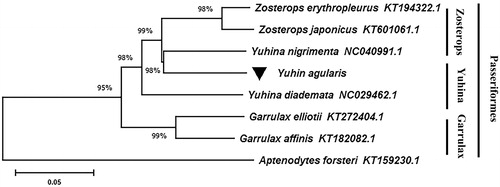Abstract
In China, the stripe-throated yuhina is mainly distributed in southwestern and the population is not abundant. In this study, we sequenced and characterized its complete mitochondrial genome. The complete mitochondrial of stripe-throated yuhina is 17,843 bp in length and contained 13 protein-coding genes, 2rRNA genes, 22 tRNA genes, and 2 control regions. The overall base composition of the mitogenome was 30.6% A, 14.1% G, 23.99% T, 31.31% C. All the genes in the stripe-throated yuhina mitogenome were encoded on the H-strand, except for the ND6 and eight tRNA genes that were transcribed from the L-strand.
Stripe-throated yuhina (Yuhina gularis) is a small-sized bird species in the family Timaliidae of Passeriformes and it is distributed in Bhutan, China, India, Laos, Myanmar, Nepal, and Vietnam, and it is listed as a Least Concern species in the Red List by the International Union for the Conservation of Nature (BirdLife International Citation2016). Its natural habitat is subtropical or tropical moist montane forests. Stripe-throated yuhina is a small bird and the length of body is 13–16 cm, the top of the head and the crest are dark brown or brownish gray, the upper body is olive brown, and the feathers are dark brown (Chris and Elphick Citation2011). In this study, we first sequenced and analyzed the stripe-throated yuhina mitogenome. The mitogenome of stripe-throated yuhina could provide molecular data for species diversity and species classification study.
The genomic DNA of stripe-throated yuhina was extracted from the muscle tissue by the traditional phenol–chloroform method (Sambrook Citation2001) and the sample was collected from Ya’an (30°0′47.20″N, 103°02′25.51″E), Sichuan province of China and stored at the Zoology Laboratory, Sichuan Agricultural University. Then, 15 pairs of primer were used to amplify the overlapping segment of its mitogenome by the polymerase chain reaction (PCR) using the software DNAstar splicing sequences and the complete mitochondrial genome was analyzed (Burland Citation2000). We have submitted the complete mitogenome of stripe-throated yuhina to GenBank with the accession number: MK405666.
The complete mitochondrial sequence of stripe-throated yuhina was 17,843 bp in length and contained 13 protein-coding genes, 2 ribosomal RNA (12srRNA, 16srRNA) genes, 22 transfer RNA (tRNA) genes, and 2 control regions (Dloop1, Dloop2) which was similar to other mitochondrial genome of Passeriformes (Xue et al. Citation2016). The overall base composition of the mitogenome was 30.60% A, 14.10% G, 23.99% T, 31.31% C. The 22 tRNA genes range from 68 to 76 bp. All tRNA genes possess the typical clover leaf secondary structure except for tNRAser which lack arm of dihydrouracil (DHU). All genes in the stripe-throated yuhina mitogenome were encoded on the H-strand, except for the ND6 and eight tRNA genes that were transcribed from the L-strand. All PCGs (NADH1, COXII, ATPase8, ATPase6, COXIII, NADH3, NADH4L, NADH4, NADH5, CYTB) shared start codon ATG, except for ND2 and COXI which began with GTG, ND6 began with CTA. Furthermore, 5 PCGs (NADH2, ATPase8, ATPase6, NADH4L, CYTB) shared stop codon TAA, NADH1 terminated with AGA, COXI stop with AGG, 6 PCGs shared incomplete stop codon. Similar to previous studies, two ribosomal RNA genes were located between the tRNAphe and tRNALeu separated by the tRNAVal (Liu et al. Citation2018). We also found that the two control regions were located between the tRNAThr and tRNAPhe separated by the tRNAPro, ND6 and tRNAGlu (Huabin et al. Citation2015).
Using the MEGA10.0 for neighbor-joining (NJ) methods to construct a phylogenetic tree (Kumar et al. Citation2018), we downloaded seven whole mitogenome of Passeriformes from the NCBI, and Aptenodytes patagonicus was used as the outgroup (). The phylogenetic tree illustrated that yuhina and Zosterops are gathered together, and we found that Y. gularis and Y. nigrimenta have close relationship, which was consistent with the previous study (Moyle et al. Citation2009).
Acknowledgements
We thank the Qian Su, Xue Liu, Pu Zhao, Yuhan Wu, Tianrui Xia, Cong Wang, Kechu Zhang, for their assistance in experiments and data analysis.
Disclosure statement
No potential conflict of interest was reported by the authors.
Additional information
Funding
References
- BirdLife International. 2016. Yuhina gularis. The IUCN Red List of Threatened Species 2016:e.T22716737A94508540. [accessed 2019 Mar 29]. http://dx.doi.org/10.2305/IUCN.UK.2016-3.RLTS.T22716737A94508540.en.
- Burland TG. 2000. DNASTAR's Lasergene sequence analysis software. Methods Mol Biol. 132:71–91.
- Chris B, Elphick S. 2011. Handbook of the birds of the world. Quart Rev Biol. 86:107–108.
- Huabin Z, Yongmin L, Xiaoyou W, Hui X, Peng Y, Xiao-Bing W. 2015. The complete mitochondrial genome of Paradoxornis webbianus (Passeriformes, Muscicapidae). Mitochondrial DNA. 26:879–880.
- Kumar S, Stecher G, Li M, Knyaz C, Tamura K. 2018. MEGA X: molecular evolutionary genetics analysis across computing platforms. Mol Biol Evol. 35:1547–1549.
- Liu X, Xu H, Zhou Y, Li D, Ni Q, Zhang M, Xie M, Wen A, Wang Q, Wu J, Yao Y. 2018. Complete characteristics and phylogenetic relationships of the Garrulax albogularis mitochondrial genome (Passeriformes: Timaliidae). Mitochondrial DNA B. 3:1272–1273.
- Moyle RG, Filardi CE, Smith CE, Jared D. 2009. Explosive Pleistocene diversification and hemispheric expansion of a "great speciator". PNAS. 106:1863–1868.
- Sambrook JR. 2001. Molecular cloning: a laboratory manual, 3rd edn. New York: Cold Spring Harbor Laboratory Press.
- Xue H, Zhang H, Li Y, Wu X, Yan P, Wu XB. 2016. The complete mitochondrial genome of Garrulax cineraceus (Aves, Passeriformes, Timaliidae). Mitochondrial DNA A. 27:147–148.

